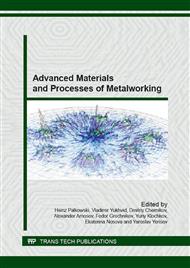[1]
O. Engler, V. Randle, Introduction to texture analysis: macrotexture, microtexture and orientation mapping, CRC Press, New York, (2010).
DOI: 10.1201/9781482287479
Google Scholar
[2]
D. Banabic, H. -J. Bunge, K. Pohlandt, A.E. Tekkaya, Formability of metallic materials: plastic anisotropy, formability testing, forming limits, Springer, Berlin, (2000).
DOI: 10.1007/978-3-662-04013-3
Google Scholar
[3]
W. Truszkowski, The Plastic Anisotropy in Single Crystals and Polycrystalline Metals, Springer, Netherlands, (2001).
Google Scholar
[4]
M.C. Smith, Principles of physical metallurgy, Harper & Brothers, New York, (1956).
Google Scholar
[5]
F.V. Grechnikov, Deformation of Anisotropic Materials: Intensification Reserves), Mashinostroenie, Moscow, 1998. (In Russ. ).
Google Scholar
[6]
D. Banabic, F. Barlat, O. Cazacu, T. Kuwabara, Advances in anisotropy and formability, International Journal of Material Forming. 3 (2010) 165-189.
DOI: 10.1007/s12289-010-0992-9
Google Scholar
[7]
L.S. Tóth, J. Hirsch, P. Van Houtte, On the role of texture development in the forming limits of sheet metals, International Journal of Mechanical Sciences. 38 (1996) 1117-1126.
DOI: 10.1016/0020-7403(95)00110-7
Google Scholar
[8]
M.A.W. Lowden, W.B. Hutchinson, Texture strengthening and strength differential in titanium-6Al-4V, Metallurgical Transactions A. 6(3) (1975) 441-448.
DOI: 10.1007/bf02658401
Google Scholar
[9]
S. Güngör, L. Edwards, Effect of surface texture on the initiation and propagation of small fatigue cracks in a forged 6082 aluminium alloy, Materials Science and Engineering A. 160(1) (1993) 17-24.
DOI: 10.1016/0921-5093(93)90493-x
Google Scholar
[10]
X.J. Wu, W. Wallace, M.D. Raizenne, A.K. Koul, The orientation dependence of fatigue-crack growth in 8090 Al-Li plate, Metallurgical and Materials Transactions A. 25(3) (1994) 575-588.
DOI: 10.1007/bf02651599
Google Scholar
[11]
A.J. Moses, Electrical steels. Past, present and future developments, IEE Proceedings A: Physical Science. Measurement and Instrumentation. Management and Education. Reviews. 137 (1990) 233-245.
DOI: 10.1049/ip-a-2.1990.0039
Google Scholar
[12]
G.H. Shirkoohi, M.A.M. Arikat, Anisotropic properties of high permeability grain-oriented 3. 25% Si-Fe electrical steel, IEEE Transactions on Magnetics. 30 (1994) 928-930.
DOI: 10.1109/20.312448
Google Scholar
[13]
F. Barlat, Crystallographic texture, anisotropic yield surfaces and forming limits of sheet metals, Materials Science and Engineering. 91(C) (1987) 55-72.
DOI: 10.1016/0025-5416(87)90283-7
Google Scholar
[14]
O. Engler, J. Hirsch, Texture control by thermomechanical processing of AA6xxx Al-Mg-Si sheet alloys for automotive applications - a review, Materials Science and Engineering A. 336 (2002) 249-262.
DOI: 10.1016/s0921-5093(01)01968-2
Google Scholar
[15]
W.B. Hutchinson, A. Oscarsson, A. Karlsson, Control of microstructure and earing behaviour in aluminium alloy AA 3004 hot bands, Materials Science and Technology. 5 (1989) 1118-1127.
DOI: 10.1179/mst.1989.5.11.1118
Google Scholar
[16]
V. Pegada, Y. Chun, S. Santhanam, An algorithm for determining the optimal blank shape for the deep drawing of aluminum cups, Journal of Materials Processing Technology. 125-126 (2002) 743-750.
DOI: 10.1016/s0924-0136(02)00382-5
Google Scholar
[17]
S. -W. Lo, J. -Y. Lee, Optimum blank shapes for prismatic cup drawing - Consideration of friction and material anisotropy, Journal of Manufacturing Science and Engineering, Transactions of the ASME. 120(2) (1998) 306-315.
DOI: 10.1115/1.2830128
Google Scholar
[18]
S.H. Park, J.W. Yoon, D.Y. Yang, Y.H. Kim, Optimum blank design in sheet metal forming by the deformation path iteration method, International Journal of Mechanical Sciences, 41(10) (1999) 1217-1232.
DOI: 10.1016/s0020-7403(98)00084-8
Google Scholar
[19]
D.V. Wilson, Plastic anisotropy in sheet metals, J. Inst. Metals. 94(84) (1966) 3-8.
Google Scholar
[20]
R. Hill, The Mathematical Theory of Plasticity, Oxford University Press, Oxford, (1998).
Google Scholar
[21]
W. Han, D. Reddy, Plasticity: Mathematical Theory and Numerical Analysis, Springer, Berlin, (2013).
Google Scholar
[22]
J. Chakrabarty, Applied Plasticity, Springer, Berlin, (2010).
Google Scholar
[23]
F.V. Grechnikov, Ya.A. Erisov, Development of yield criteria for calculation of forming of highly textured anisotropic blanks, Vestn. Samara Gos. Aerokosm. Univ. 1 (2012) 94-99. (In Russ).
Google Scholar


